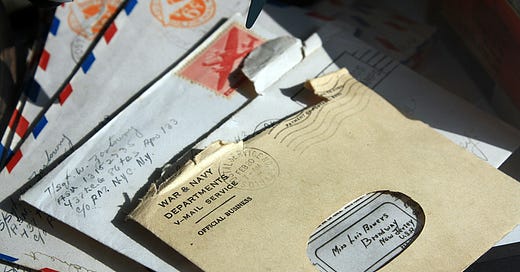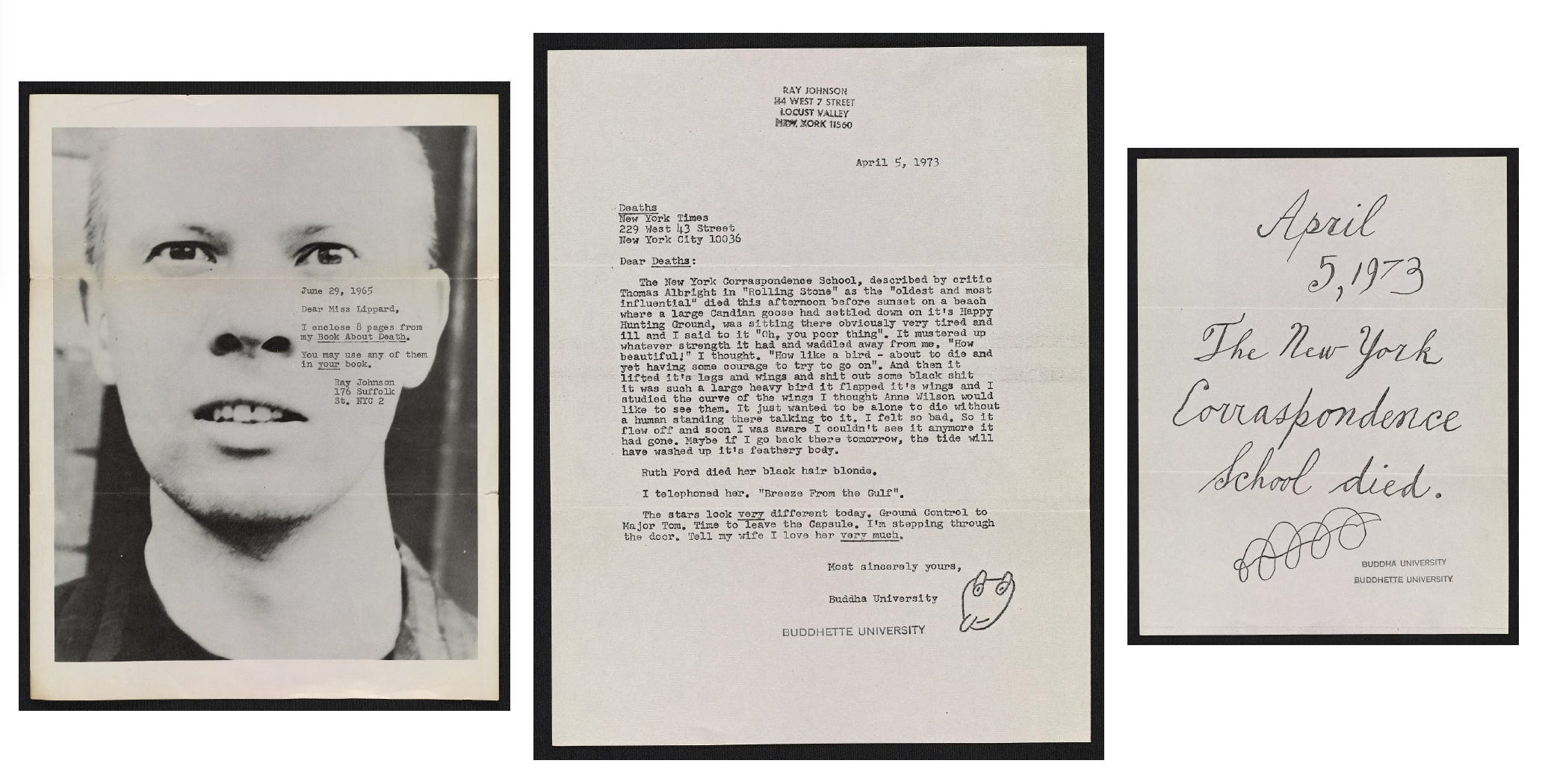Hi Friends,
I created a presentation on mail art in grad school and it was a hit with not only my classmates but also the instructor. He asked me if he could used it as an example for his course the following semester. It felt like the equivalent of receiving a gold star. That presentation inspired this post. Enjoy!
- Queer Archivist
Mail Art, also known as Correspondence Art, is the creation and exchange of small scale art through the postal system. Consisting of materials such as postcards, hand decorated envelopes, unique rubber stamps, stickers, collage, and any other material or object that can be sent through the postal system. Mail Art was heavily inspired by the Dada art movement of the early 20th century, which used similar techniques such as photomontage, collage, doodles and other less traditional art techniques.
Like Dada-ism, Mail Art worked to transform the art world by making viewers and critics question what can be considered art. Artist like Carol Schneck and John Baldessari used Mail Art to express their separation from the mainstream art world, as you will see later in this post.
Mail Art challenged the hierarchies of the art world by offering a new way to share art. Instead of relying on museums or galleries, these artworks were sent directly to recipients, making art more accessible. This method allowed people without access to traditional gallery spaces to create, receive, and share thought-provoking pieces. Each Mail Art piece in this exhibition demonstrates the radical possibilities of Mail Art and how it continues to evolve, providing artists with a space to address and challenge modern societal issues.
A Very Brief History: Ray Johnson & The New York Correspondence School
American artist Ray Johnson is credited as being a major contributor in the growth of Mail Art into the global art movement it is today. In the early 1960’s he created the New York Correspondence School (NYCS), which was not a school as the name would suggest, but rather a name given to the trusted group of people who Johnson chose to send his works to via the postal service. Mail Art was an artform that facilitated new modes of participatory art exchange that had been made inaccessible by the mainstream art community. For Johnson, Mail Art was about the exchange. His pieces often asked those receiving the art to alter it and send it back to him or to another recipient. In this way, Mail Art was both a form of artistic expression as well as a unique mode of communication.
In the realm of art, where exclusivity often reigns supreme, mail art emerges as a disruptive force, challenging the elitism and gatekeeping that characterize traditional art spaces. By embracing the democratic nature of postal systems, mail art transcends physical and geographical boundaries, offering a platform for marginalized voices and perspectives to be heard.
This piece was created by Carol Schneck and sent to John Held Jr. It features an image of the Whitney Museum of American Art (the original location) in a trash can with the words “Mail art is not museum art” written on it. The handwritten text surrounding the trashcan reads: “Stop saving garbage! Mail art is disposable art; shred it! Wrap fish in it! Give it to the gerbil! Don't file it! Use it! Abuse it!”
This provocative piece by Carol Schneck serves as a poignant commentary on the relationship between mail art and institutionalized forms of art. By depicting the Whitney Museum of American Art, a symbol of establishment and prestige, discarded in a trash can, Schneck challenges the notion that art must be preserved and revered within traditional museum settings. The handwritten message urging viewers to "Stop saving garbage!" and to instead embrace the disposability of mail art underscores the medium's rebellious spirit and rejection of commodification. Through its bold visual imagery and defiant rhetoric, Schneck's artwork invites viewers to reconsider the value systems that govern the art world and to embrace the ephemeral and transgressive nature of mail art.
This piece was made by John Baldessari and sent to to Lucy Lippard. The piece consists of a typescript essay entitled "The Best Way to Do Art." The essay discusses the artist's disillusionment with the art world, and his realization of the inaccessibility of traditional art/paintings versus mailed art. He ends the letter with “Moral: It’s difficult to put a painting in a mailbox”
the artist offers a candid reflection on his disillusionment with the conventional art world. Through a typescript essay, Baldessari explores the accessibility and limitations of traditional art forms compared to mail art. His musings shed light on the inherent exclusivity of paintings and the constraints they face in reaching a broader audience beyond gallery walls. The poignant conclusion, "Moral: It’s difficult to put a painting in a mailbox," encapsulates Baldessari's recognition of the transformative potential of mail art in circumventing traditional art-world barriers. By embracing the medium of mail art, Baldessari challenges the status quo and advocates for a more democratic and inclusive approach to artistic expression.
The Ephemeral Qualities of Mail Art: Material Object vs. Conceptual Art
There is a fascinating interplay between material object and conceptual art within the realm of mail art, exploring how artists navigate the ephemeral qualities of the medium. Rooted in the experimental ethos of the Fluxus art movement, mail art transcends traditional artistic boundaries, emphasizing the conceptual and performative aspects of artistic expression.
Fluxus artists Ken Friedman and Fletcher Copp mail art to Lucy Lippard consisting of one sock, painted with various different colors and a note about Ken and Copp's "sock of the month." The note is handwritten and illustrated with ink drawings. Through examining this piece we witness a shift towards a more conceptual practice that prioritizes the idea and performance of the artwork over its materiality. Join us as we explore how this innovative approach challenges traditional notions of artistic value and permanence, blurring the boundaries between material object and artistic concept in the realm of mail art.
This Mail Art piece by Ray Johnson, a pioneer of the genre, was sent to his friend and art critic, David Bourdon. Enclosed within the unconventional medium of a spray-painted metal mailbox are a multitude of smaller mail art pieces, predominantly consisting of printed paper materials. Johnson's innovative creation not only showcases his mastery of the medium but also speaks to the expansive possibilities inherent in Mail Art. Through this assemblage of diverse pieces, Johnson invites the viewer into an immersive and deeply personal experience—one that transcends the confines of traditional art spaces. Unlike static exhibits in museums, Johnson's piece encourages tactile exploration and intimate engagement, fostering a dynamic relationship between the viewer and the artworks. In this way, Johnson demonstrates the unique capacity of Mail Art to create interactive and multisensory encounters that defy the limitations of traditional artistic practices.
Conclusion
Through its ephemeral qualities and conceptual nature, Mail Art invites us to rethink the value of artistic expression and embrace the democratization of creativity. As we reflect on the legacies of pioneering figures like Ray Johnson, who pushed the boundaries of Mail Art with boundless imagination and irreverent wit, we are inspired to continue exploring this vibrant artistic movement and its enduring impact on contemporary culture. Stay tuned for future mail art endeavors, including the possibility of launching a correspondence school inspired by the visionary spirit of Ray Johnson. Let's keep the conversation going and celebrate the limitless possibilities of artistic expression through Mail Art!












I've been doing this and had no idea it was an art medium. I feel like things are clicking for me. Thank you for posting this!
I don't know if this constitutes mail art, but I have in the past enjoyed making colorful envelopes out of wall calendars. It is a simple quick project for a distracted brain, but recipients always seem to enjoy the surprise of receiving some personal mail in them! The trick is getting calendars cheap in Feb or asking friends to save you theirs when the year is over.